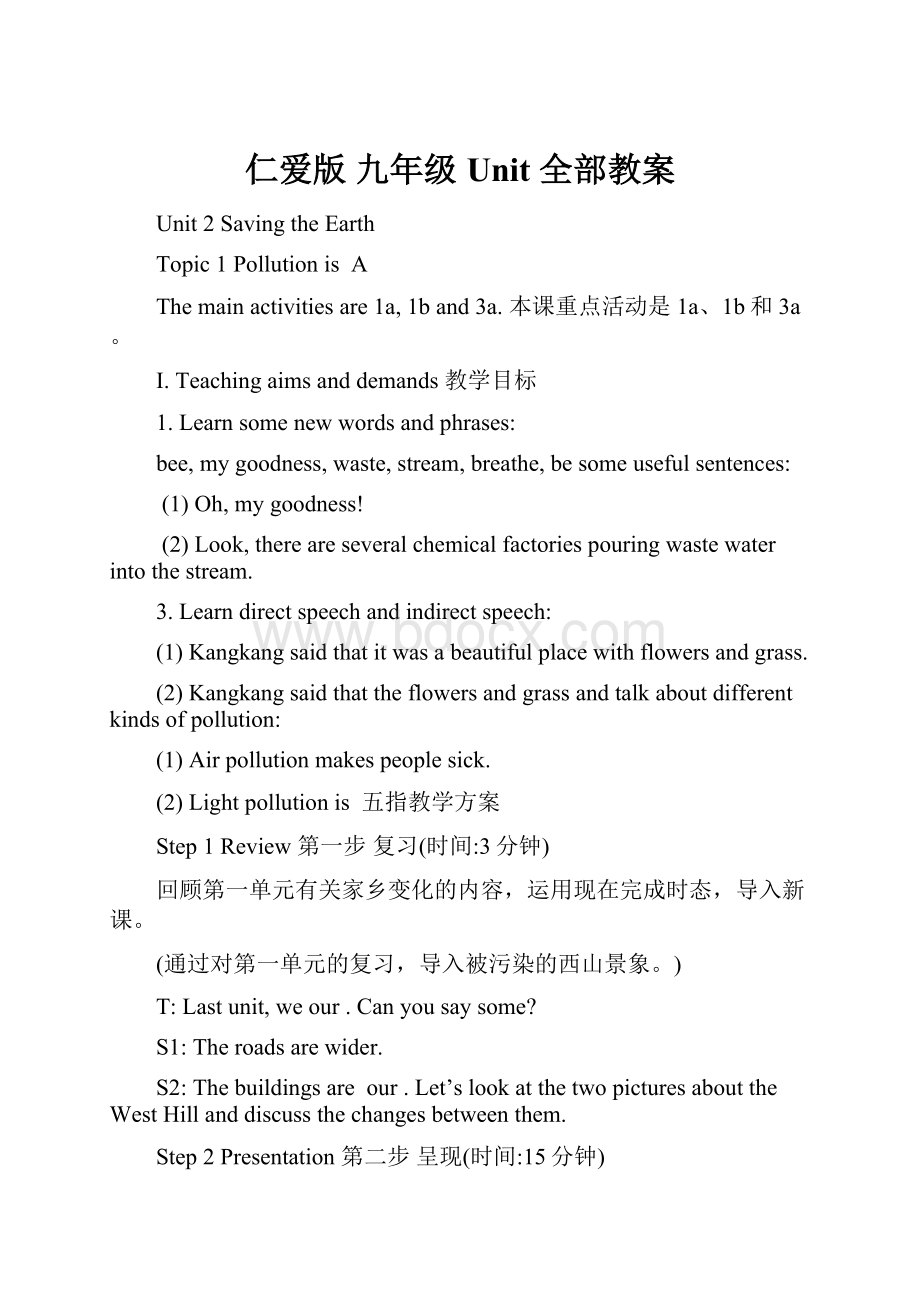 仁爱版 九年级 Unit全部教案.docx
仁爱版 九年级 Unit全部教案.docx
- 文档编号:10150537
- 上传时间:2023-02-08
- 格式:DOCX
- 页数:64
- 大小:51.13KB
仁爱版 九年级 Unit全部教案.docx
《仁爱版 九年级 Unit全部教案.docx》由会员分享,可在线阅读,更多相关《仁爱版 九年级 Unit全部教案.docx(64页珍藏版)》请在冰豆网上搜索。

仁爱版九年级Unit全部教案
Unit2SavingtheEarth
Topic1PollutionisA
Themainactivitiesare1a,1band3a.本课重点活动是1a、1b和3a。
Ⅰ.Teachingaimsanddemands教学目标
1.Learnsomenewwordsandphrases:
bee,mygoodness,waste,stream,breathe,besomeusefulsentences:
(1)Oh,mygoodness!
(2)Look,thereareseveralchemicalfactoriespouringwastewaterintothestream.
3.Learndirectspeechandindirectspeech:
(1)Kangkangsaidthatitwasabeautifulplacewithflowersandgrass.
(2)Kangkangsaidthattheflowersandgrassandtalkaboutdifferentkindsofpollution:
(1)Airpollutionmakespeoplesick.
(2)Lightpollutionis五指教学方案
Step1Review第一步复习(时间:
3分钟)
回顾第一单元有关家乡变化的内容,运用现在完成时态,导入新课。
(通过对第一单元的复习,导入被污染的西山景象。
)
T:
Lastunit,weour.Canyousaysome?
S1:
Theroadsarewider.
S2:
Thebuildingsareour.Let’slookatthetwopicturesabouttheWestHillanddiscussthechangesbetweenthem.
Step2Presentation第二步呈现(时间:
15分钟)
通过比较1a的两幅图画的差异,展开对话,学习部分生词,呈现1a。
1.(利用幻灯片展示1a中的两幅图,师生问答。
)
T:
Arethereanydifferencesbetweenthem?
Ss:
Yes.
T:
Let’slookatPicture1.Whatcanyousee?
S1:
Icanseesomeflowersandgrass.
S2:
Icanseesomebutterfliesdancing.
T:
Yes,therearesomebutterfliesdancing.
(板书并要求学生掌握。
)
thereisare…doingsth.
T:
Whatelsecanyousee?
S3:
Icanseearabbit.
S4:
Icanseesomethestream.
(板书并要求学生掌握。
)
stream
T:
WeknowtheWestHillwasabeautifulplace.LookatPicture2.Oh,mygoodness!
What.
S10:
Therearesomefactories.
T:
(指着工厂。
)Yes,thereareseveralfactories.Theyarechemicalfactories.
(板书并要求学生理解。
)
chemical
T:
(指着工厂冒的黑烟,并捂住鼻子做呼吸困难状。
)Theyaremakingmuchsmoke.Itcancausebreathingproblems.
(板书并要求学生掌握。
)
breathe
T:
(指着排放的废物。
)Andtheyarepouringwastewaterintothestream.
(板书并要求学生掌握。
)
waste
T:
FromPicture2,weknowthechemicalfactoriesaretothetapecarefully,thenanswerthesequestions.
(出示小黑板上的问题,听录音1a。
)
(1)Wherearetheygoingtohavethepicnic?
(2)WhydoesKangkangsay“Oh,mygoodness!
”?
3.(核对答案,板书1a的关键词。
)
beautiful—fresh—clean—gone—dirty—terrible—wastewater
Step3Consolidation第三步巩固(时间:
12分钟)
复述1a,引入本课重点,讲解和操练“直接引语”与“间接引语”,完成1b。
1.(要求学生在限定时间内,根据黑板上的关键词复述对话。
)
T:
Trytousethekeywordsontheblackboardtoretell1a.
Example:
Inthepast,theWestHillwasabeautifulplacewithflowersandgrass.Wecouldseebeesandbutterfliesdancing.Theairwasfresh,thewaterwasverycleanandwecouldseefishswimming.Butnow,alltheflowers,grass,bees,butterfliesandfishtherebefore.
T:
Yes.Kangkangsaidthattherebefore.
T:
Next,please.
S2:
It’sabeautifulplacewithlotsofflowersandgrass.
T:
OK.Kangkangsaidthatitwasabeautifulplacewithlotsofflowersandgrass.
T:
Next,please.
S3:
Theairisfreshandthewaterisclean,andyouwillsee…
T:
SoKangkangsaidthattheairwasfreshandthewaterwasclean,andtheywouldsee…
(板书以上三个画线句子,要求学生将板书与1a中的原句对比找出不同之处,教师引导和补充。
学习“直接引语”和“间接引语”。
)
Kangkangsaidthattherebefore.
Kangkangsaidthatitwasabeautifulplacewithlotsofflowersandgrass.
Kangkangsaidthattheairwasfreshandthewaterwasclean,andtheywouldsee…
3.(让学生完成1b,并作报告。
)
T:
Filloutthetablein1b,thengiveareport,using“KangkangMariasaid…”.
Step4Practice第四步练习(时间:
10分钟)
通过听力训练,引出污染的概念,充分调动学生的积极性,加深对各种污染及其危害的理解,完成2和3b。
1.(播放2录音,学生听后完成2。
)
T:
Weknow,withoutplantsandanimals,theWestHillisn’tbeautiful.Soplantsandanimalsareimportant.Let’slookatthelovelyanimalsinthepicturesin2.Listentothetapeandwritedownthenumbersofthecorrectpictures.
(若学生没听懂,可再放一遍,核对答案。
)
2.(学生看图完成3a。
)
T:
Afterlistening,doyouknowwhatdoesgreat.
T:
Yes.There’remanykindsofpollution.Let’slookatthepicturesin3aandmatchthemwiththephrasesgiven.Trytoguessthemeaningofsoil.
(板书并要求学生理解。
)
soil
(核对答案。
)
3.(让学生用3a的短语完成3b。
)
T:
Pollution3a.
(核对答案,并板书influence,要求学生掌握。
)
influence
Step5Project第五步综合探究活动(时间:
5分钟)
通过游戏及调查的方式,加深学生对污染及其危害的印象,增强学生的环保意识。
1.Guessinggames.
(教师让一学生到讲台,从3a所提供的有关污染的图片中任取一张,正面面向全体学生,背面面向自己。
台下学生描述图片上的内容或引起的污染问题,让台上的学生猜出该种污染的名称。
)
T:
Everyoneofyoucandescribethepicture.Andthestudentinthefrontoftheclassroomtriestotelluswhatkindofpollutionitis.
Example:
(S1任意抽取一张图片。
)
S2:
It’sproducedinafactory.(教师帮助学生描述。
)
S3:
Itsmellsterrible.
S4:
It’s.
…
2.Homework:
Makeasurvey.
(调查你们家附近的污染状况,并填写表格,以增强学生的环保意识。
)
T:
Nowmakeasurveytostudythepollutionaroundyour.
Pollution
Reason
Effect
Airpollution
Soilpollution
Waterpollution
Lightpollution
Noisepollution
Litter
板书设计:
PollutionisA
airpollutiontherebesb.sth.doingsth.
soilpollutionbeKangkangsaidthatitwasabeautiful
lightpollutionplacewithflowersandgrass.
noisepollutionThegovernmenthasdonesomething
litterusefultostopit.
SectionB
Themainactivitiesare1aand1b.本课重点活动是1a和1b。
Ⅰ.Teachingaimsanddemands教学目标
1.Learnsomenewwords:
weak,produce,chest,anyway
2.Goonlearningdirectspeechandindirectspeech:
(1)Theoldladysaidthatitwasdifficultforlikethatsincetheweekbefore.
(3)Kangkangaskedtheoldladylikethat.
(4)ThejournalistaskedMrs.Zhouwhetherifshewasfeelingbetterthen.
(5)Thejournalistaskedwhattheenvironmentaroundthatplacewaslike.
3.Learnsomeexpressionsaboutblameandcomplaint:
(1)It’sdifficultformetobreathe.
(2)Thebadairmakesmychest’tsleepwellatnight.
(4)I’malwaysinabadmood…
(5)…Ican’tstandtheenvironment.
Ⅱ.Teachingaids教具
图片教学挂图录音机小星星游戏纸条
Ⅲ.Five-fingerTeachingPlan五指教学方案
Step1Review第一步复习(时间:
6分钟)
检查上节课的作业,通过学生对调查结果的汇报和转述,复习直接引语和间接引语。
T:
Isthereairpollutionaroundyourfeelsick.
T:
WhatdidS1sayjustnow?
S2:
S1saidthattherewereseveralchemicalfactoriesnearfeltsick.
(其余五种污染用同样的方法进行转述。
)
…
Step2Presentation第二步呈现(时间:
12分钟)
继续展示有关环境污染的图片,开展对话,学习生词,呈现1a。
1.(教师用SectionA的1a进行导入,利用图片引出新的词汇。
)
T:
From1a,SectionA,weknowKangkangandthechildrenreachedtheWestHill,wouldtheymakepeople’schestache.(教师做捂胸皱眉状。
)
(板书并要求学生掌握。
)
chest
T:
What’smore,thefactorymakestoomuchnoise.Whatproblemsdoesnoisepollutioncause?
S1:
Maybepeoplecan’tsleepwell.
T:
Yes,itmakespeopleweak,andpeoplemaybeinabadmood.
(板书并要求学生掌握。
)
weak
T:
Pollutioncausestoomanyproblems.Anyway,weshoulddosomethingtostopit.
(板书并要求学生掌握。
)
anyway
2.(呈现1a图片。
)
T:
Lookatthepicture.Whoaretheyinthepicture?
Ss:
TheyareKangkangandGranny.
T:
Whatotherthingscanyousee?
S2:
Icanseesomedeadfish.
S3:
Thebirdonthetreeisdying.
S4:
Somechemicalfactoriesareproducingterriblegas.
S5:
Factoriesarepouringwastewaterintotheriver.
T:
Soitcauseswaterpollutionandairpollution.LookatKangkangandGranny.Whataretheytalkingabout?
Listentothetape,andthenanswerthequestion.
(教师放1a录音,学生听后回答。
)
Ss:
Theyaretalkingaboutpollution.
T:
Yes,youareright.
3.(学生齐读课文,找出疑难点,教师解释,并板书要点,要求学生掌握短语can’tstand及句型Howlong…。
)
can’tstand(doing)sth.
Howlonglikethis?
I’malwaysinabadmood…
Anyway,I.
It’sdifficultformetobreathe.
Thebadairmakesmychesthurt.
Step3Consolidation第三步巩固(时间:
9分钟)
采用表演及竞赛的方法,充分调动学生积极性,继续巩固直接引语与间接引语,巩固1a,完成1b。
1.(让学生再读1a对话,并要求和同桌一起表演,完成1a。
)
T:
Read1aaloud,andtrytoactoutthedialoginpairs.
(请几组上台表演。
)
2.(学习1b。
将学生分成四组进行比赛,看哪组同学的观察思维能力强。
每发现一条变化规则,即为本组加一颗星。
教师可适时地引导。
)
T:
Read1bcarefully,andtrytofindoutthechangingrules.Let’slikethat.
S2:
Theoldladysaidshewasalwaysinabadmood.
S3:
Kangkangsaidthatwastoobad.
…
(教师进行补充和总结,并对获胜组进行表扬和奖励。
)
3.(学生独立完成1b。
)
T:
Complete1bbyyourselvesintwominutes.
(必要时教师给予帮助。
)
Step4Practice第四步练习(时间:
12分钟)
设置情景展开对话,操练及强化疑问句变成间接引语的方法,完成2;展开小组讨论,完成3。
1.(引导学生发现一般疑问句变成间接引语的方法。
)
T:
AfterKangkangwrotetothenewspaperabouttheoldlady’sproblems,ajournalistinterviewed?
Let’slookatthefirstpicturein2.
Ss:
Areyoufeelingbetternow,Mrs.Zhou?
T:
Yes.Thejournalistaskedtheoldladyifshewasfeelingbetter.
2.(师生对话,让学生先口头练习,然后书面完成2。
)
T:
WhatisMrs.Zhou’sanswer?
Ss:
She’sfeelingevenworse.
T:
Yes.Pleaseansweritwithindirectspeech.
Ss:
Mrs.Zhou’ssaidthatshewasfeelingevenworse.
T:
Then,whatdidthejournalistask?
Ss:
Whatistheenvironmentaroundthisplacelike?
T:
Pleaseansweritwithindirectspeech.
Ss:
Heaskedwhattheenvironmentaroundthatplacewaslike.
T:
Completetherestsentenceswithdirectspeechorindirectspeech.
…
(核对答案。
)
3.(三人一组练习:
一人问,一人回答,一人作汇报,要求用到所学的间接引语知识。
完成3。
)
T:
Discussthequestionsin3,andworkingroupsofthree.Oneasks,anotheranswersandthethirdonereportsitusingindirectspeech.Twominutesforpreparation.
Step5Project第五步综合探究活动(时间:
6分钟)
通过做游戏的方式,继续巩固直接引语与间接引语,布置有关环境内容的作文,加强本课功能句型的运用。
1.Playagame.
(传话:
分给每组第一位同学一张纸,上面事先写好同一句话Howistheenvironmentaroundthisschool?
(即直接引语)。
这位同学要以间接引语的形式(Theteachersaidasked…)口头向第二个同学传话,然后依次往后传,最后接到话的同学要使用直接引语说出原句。
传得又快又正确的组获胜。
注:
各组人数要一样多。
如果时间允许,可以换一个句子继续游戏。
)
2.Homework:
Writetothegovernmentaboutthepollutionproblemsaroundyour?
Ss:
Yes.Suchaswaterpollution,soilpollution,lightpollution,airpollution,noisepollutionandsoon.
T:
Whatproblemsdotheycause?
S1:
Waterpollutioncanmakepeoplesick.
S2:
Soilpollutioncausesunhealthyfood.
S3:
Lightpollutioncausesbreathingproblems.
…
T:
Verygood.Inthislesson,let’stalkaboutwhatkindsofnoisepollutionare.
Step2Presentation第二步呈现(时间:
15分钟)
利用图片导入生词教学,同时结合环境污染内容,创设情景,呈现1a。
1.(展示图片,导入生词。
)
T:
Let’slookatthepicture.
(教师展示图片一。
)
T:
(指着图片。
)Whatisburningcoalcausepollution?
Ss:
Yes.Burningcoalcancauseairpollution.
T:
You’reright.
(教师展示图片二。
)
T:
Lookatthepicture.People
- 配套讲稿:
如PPT文件的首页显示word图标,表示该PPT已包含配套word讲稿。双击word图标可打开word文档。
- 特殊限制:
部分文档作品中含有的国旗、国徽等图片,仅作为作品整体效果示例展示,禁止商用。设计者仅对作品中独创性部分享有著作权。
- 关 键 词:
- 仁爱版 九年级 Unit 全部教案 仁爱 全部 教案
 冰豆网所有资源均是用户自行上传分享,仅供网友学习交流,未经上传用户书面授权,请勿作他用。
冰豆网所有资源均是用户自行上传分享,仅供网友学习交流,未经上传用户书面授权,请勿作他用。


 1212中级汽车维修工考试试题三.docx
1212中级汽车维修工考试试题三.docx
